Will workplaces still exist in the future, or will everyone wear an AR headset and work from home? The steps toward a possible AR-based workstyle will be gradual and involve different types of work. Each workstyle type has advantages, but we can measure where work is conducted through workplace occupancy tracking.

Often, an impulsive conclusion seems to be forcing workers into one type of workstyle without considering the outcome of the return-to-work strategy or the purpose of the workplace. Let’s look at some best practices to get us closer to the workplace of the future, where collaboration and productivity thrive.
Why we write about this topic: At Kisi, we aim to connect people and spaces. Whatever work style, hybrid work policy, or attendance metrics you choose, Kisi’s hybrid work access control solution can help by providing a great work experience, granular occupancy insights, and dynamic access permissions based on bookings.
Return to office data sources, trends and research #
There are many sources providing insight into return to office data and trends. Here are some back to office data sources we found useful. Local governments like New York City produced Return to Office Survey and San Francisco is measuring San Francisco Office Attendance. There aren’t a lot of scientific institutions - Nick Bloom’s WFH research seems to be the most prominent one. Consulting firms like Statista or Gallup provide indexes and data as well. Of course office vendors like Kisi also have valuable data and we produce our real time Office Occupancy Index and modern corporate workplace have put out their own reports like Team Anywhere at Atlassian has done in their 1,000 days of distributed work.
In terms of terminology we found that the most commonly accepted definitions of data points at workplaces are:
- Office capacity: The total number of available workstations
- Office occupancy: How many people are coming to offices
- Office utilization: How offices are used by people coming to the office
During our research we worked with different hybrid work experts we will be referencing throughout the article:
- Liza Mash Levin, CEO and Co-founder at Gable (all-in-one workplace management platform)
- Michael Samuels, General Manager at Flex Index (top source for workplace flexibility)
With that in mind - let’s look at the different work models.
Work models #
Work models encompass the various structures and arrangements through which work is organized and executed within an organization.
They affect where employees complete their daily tasks as well as their interaction and collaboration. We differentiate 3 varying work models we've observed in the modern workforce, which we'll showcase below.
We'll also show how workplace presence presents itself in occupancy reports. Occupancy reports give insight on how many people were on-site during a given week or day. Occupancy indexes like Kisi’s Return to Office show aggregate occupancy based on individual access data, including badge swipes.
Mostly on site
Mostly remote
Hybrid
- On-site workers are on-site every workday doing in-person work.
- On-site first workers are typically on-site but might travel or remote work sporadically.
- Remote workers / work from home (WFH) staff are working from home, or in an individually organized shared workplace such as a coworking space.
- Remote first workers typically do not work at an official company location but might come on-site from time to time.
- Hybrid workers regularly work on-site for a reduced number of workdays, while for the remaining workdays, they work from home.
- Roaming workers work on longer ranges from different offices around the globe. Their work is best measured as occupancy across all offices.
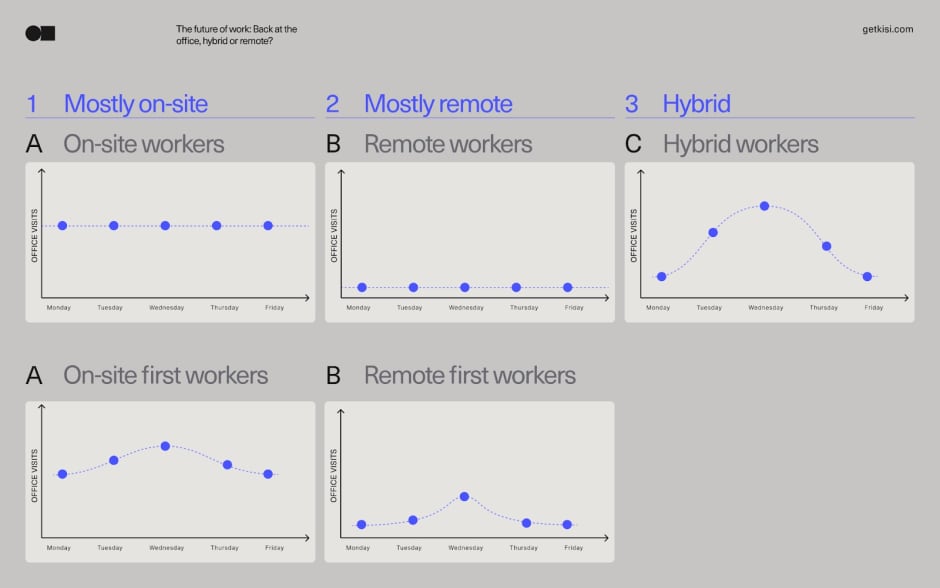
“When we look at different work styles, it is important to consider a variety of different factors including team purpose, team distribution and different geographies which all could have a different impact on workplace usage other than personal motivation”, says Liza Mash Levin, CEO at Gable.
Working in different geographies #
Are work models equally distributed in different parts of the world? When analyzing Kisi’s occupancy data by geographic region, it becomes clear that Europe consistently tops the occupancy range while the US trends towards the bottom. Keeping in mind regional differences in occupancy benchmark is a very important consideration.
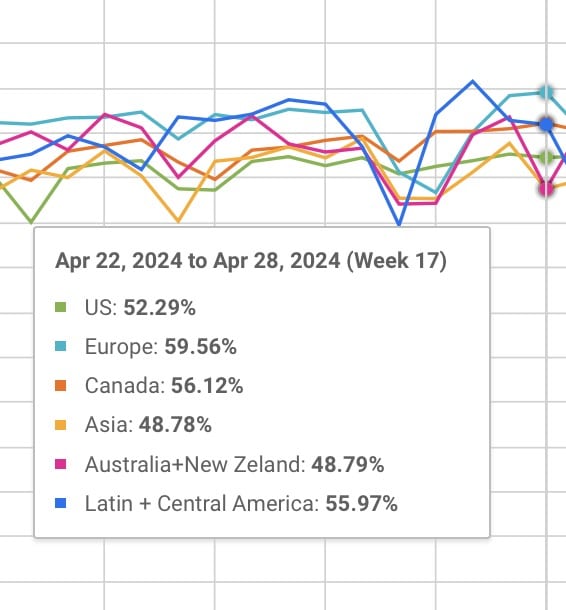
Purpose by team #
In-person work should foster collaboration for most teams regardless of the preferred work model. The dramatically increased on-site events held rate starting in 2024 corroborates this. It indicates a larger shift to using offices as collaboration hubs. For companies looking to make use of offices, this might be a more important metric than the average occupancy if the company’s office goal is collaboration.
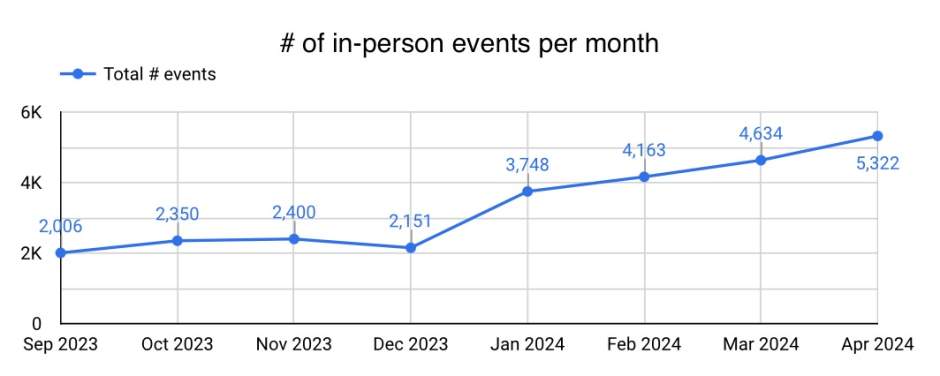
To measure the on-site collaboration including offsite events - regular surveys could provide helpful additional insights as shown below. A small number of employees attended 5 or more in-person social events.
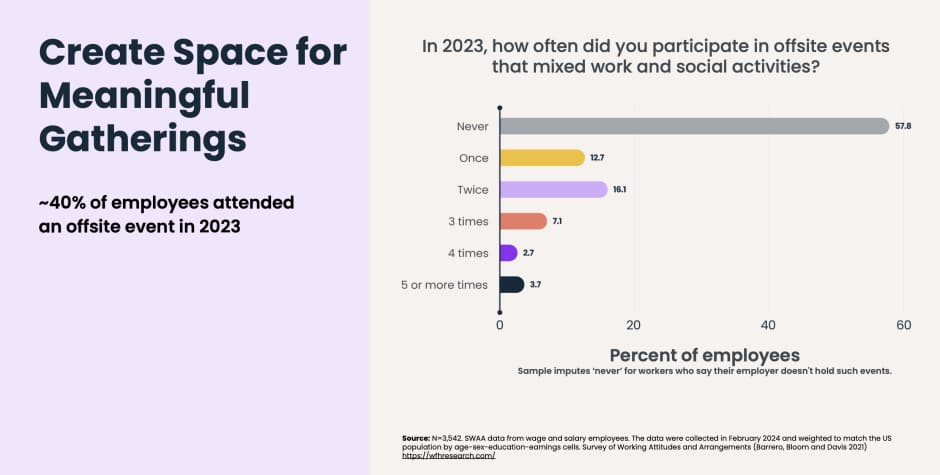
This data can and should be sliced by different teams as usage policies and occupancy might differ a lot depending on how these teams use offices.
Occupancy by team #
Assigning different workstyles to teams can be helpful and measuring those different patterns separately from an average occupancy could be a natural consequence. Below is an example of how this tracking could looks like separated by employee groups that work on site from the office:
- Every workday
- At least 2-3 days a week
- About once a week
- About once a month
- Never
To understand office usage, we compared research survey data with actual employee behavior patterns - and found significant differences. Keep in mind the sources of the data are different, so these charts are not based on the same dataset. While the core metrics of using the office about once a month and 2-3 days a week are pretty close together, you see that almost more than 10% more of employees who answered “never using the office” are actually never showing up. At the same time the survey indicated a very high percentage of every day office workers at 26%, but in a separate dataset of occupancy measured by badge swipes it looks like only close to 4% of workers actually show up every day. Naturally, there might be exceptions when someone is sick, has a doctor's appointment, or uses a vacation day. This is why it’s great to have both data sets next to each other and compare where people think they are vs where we’re currently really at.
Office occupancy based on badge swipes
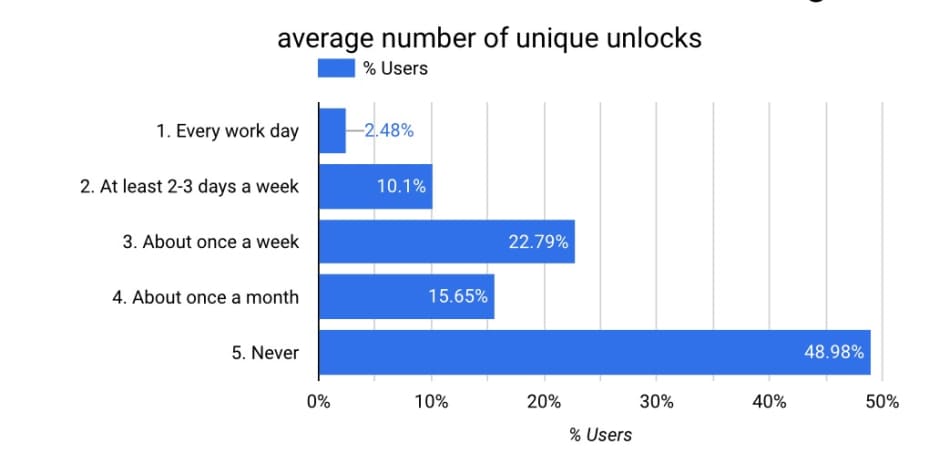
Office occupancy based on survey results
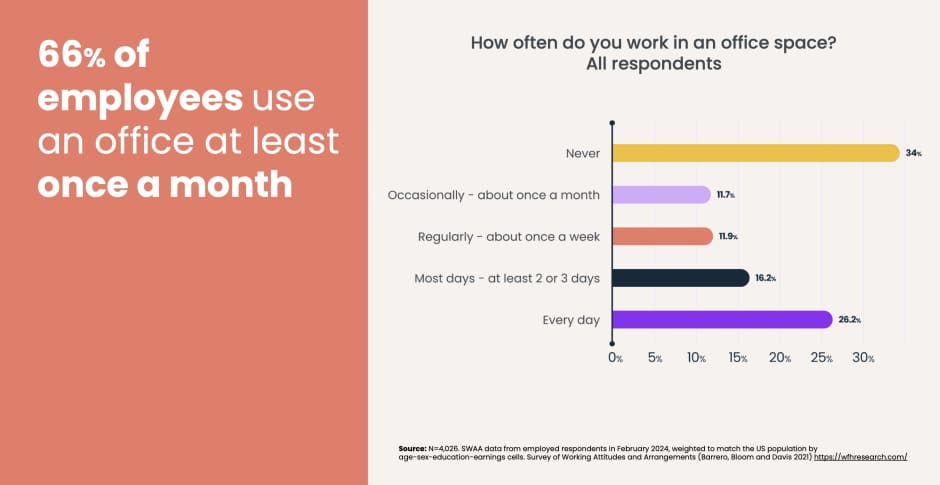
Return-to-office strategy #
Drafting a great return-to-office (RTO) strategy is essential to help your workforce navigate the changing work models. Let's ensure you don't fall victim to some first-impulse initiatives first.
Office occupancy and engagement metrics #
Unfortunately, many companies start with first-impulse initiatives when it comes to back-to-work plans. This often means an executive looks at one of the core office usage metrics, such as office occupancy.
Office occupancy rate
How does my office occupancy rate compare to other companies that also require three days per week in person?
- Inputs: Required office days per week, office capacity, average daily attendance
- Outputs: Occupancy rate vs. peers requiring three days per week in office
Sometimes, this approach can make sense if it’s required for compliance or related to the company's mission. Unfortunately, executives often spontaneously make this critical decision without much additional context or consideration.
Allocation of office space
How are other hybrid companies in my industry allocating their space between individual spaces (e.g. desks) and communal spaces?
- Inputs: Office square footage, office capacity, desk count, office allocated employee count
- Outputs: Desks per square foot, desks vs space capacity, desk sharing ratio vs. peers
If you realize your office's average occupancy is only 30%, reducing its footprint by 70% might be the logical conclusion. Too many executives jump to that strategy without considering what else the office could be and giving it a new purpose.
According to Michael Samuels from Flex Index, the allocation of office space is becoming more of a hot topic as it relates to real estate cost metrics. He says, “The data is new - leaders need it to strategize and benchmark against other companies. Once they are familiar with the basic metrics, they will start to analyze office utilization by team and by space purpose to calculate workstation vs collaboration vs event return and cost."
Office ROI metrics by allocation
These are the three office space ROI metrics for facilities and real estate executives:
- Workstation cost per employee
- Collaboration cost per collaborator
- Event cost per participant
Policy change on engagement
If we increase the required office time to four days per week, should we expect an impact on engagement or turnover?
- Inputs: Required office days, eNPS, turnover rate
- Outputs: Office requirements vs. peers, eNPS vs. peers, turnover rate vs. peers
Short-fused policy changes with hopes for long-term workforce impacts that can’t immediately be measured are dangerous and most likely counterproductive.
In this instance, Michael Samuels recommends for stakeholders to pull in engagement data from people tools such as Lattice or Culture Amp that already have the data to correlate with other office usage data.
Workplace analysis #
A real return to work strategy starts with a solid understanding of your workplace usage. The workplace strategy often includes the real reason why employees should return to the office. Executives often mention productivity increases by returning to the office and collaborating in person to be the reason.
Workplace occupancy can be considered a measure for successfully implementing hybrid work in those cases. The question over time becomes: Is remote work going away? The clear answer is: No, but pure remote work will definitely happen less frequently as more workplaces switch to different hybrid work models.
Analysis of workplace occupancy data #
Once the occupancy and usage patterns are clear, you can start planning based on average, day, group, or team and behavior-based occupancy. With cloud-based access control like Kisi, you can predict which days are typically busiest and what an average occupancy looks like. Understanding inputs like presence prediction of typical arrival, typical daily presence, and total presence at the office for the past months can be crucial.
Workplace analysis template #
The first step in your workplace strategy could be to determine how many percent of regular working staff you have in which category. A template for workplace analysis data could look something like this:
On-site workers
Remote workers / work from home (WFH) staff
Hybrid workers
15%
30%
25%
On-site first workers
Remote first workers
Roaming workers
15%
13%
2%
Analysis
Goal
- 55% of staff is typically on site (Adding on-site and hybrid workers)
- 45% of staff is mostly working remotely
- Which roles can be remote vs which roles have to be on-site?
- How can we make the on-site experience more productive for workers who are already there?
- What would increase collaboration or productivity for remote workers so that they would consider working from an office?
- Clear remote work vs. hybrid work vs. on-site work strategy
Planning, monitoring, and reacting to space utilization #
The advantage of analyzing occupancy data on a weekly, monthly, and quarterly cadence is that you are able to react to utilization in an iterative manner. This gives you great context of how the spaces are used over a period of time and enables you to answer essential questions, including: Are there recurring monthly patterns? Which teams used the office the most? How many spikes (meetups) were there?

Real-time occupancy data can get you real-time updates on how the office is performing currently. You can scale this globally for each office so your workplace team can stay alert with push notifications on Slack or Microsoft Teams. Get proactive with monitoring occupancy and getting alerts when spaces fill up more than expected.
Individual occupancy usage patterns can be helpful when overlaying it with intended routines and calculate adherence if required.

Return to office types #
Once you have analyzed your workplace usage, you can start deciding what type of workplaces you want to operate and which work options you want to offer. It’s hard to make a black and white decision to work from home vs establish a corporate workplace. The way many companies make a high level decision on how to use real estate is usually in line with the company's mission. The companies’ mission and purpose is typically a good idea to start there when making a decision to work from home or establish a corporate workplace.
Liza says, “Real estate is a very capex-heavy industry. The industry is going through a transformation, and the real estate stakeholder needs flexibility and access to an offering for a range of different needs. But it all depends on the company philosophy and what your North Star is. Some companies say: “We hire the best talent wherever they are.” Then you don't have to have offices everywhere. A flexible 3rd space model makes sense in that case. If you have hubs, there is a reason for where they are and why people are hired there. Either way, it comes down to making the best work model decision for your company and employees”.
- There are fully remote companies, e.g. GitLab
- There are virtual first companies, e.g. Atlassian, Dropbox
- There are in person only companies such as Tesla or JP Morgan
There are many workplace blueprints to learn from. Yet, some questions need to be answered first: Do you have the leadership buy-in and backing? Can the company strategy support it? Only then can you start thinking about the implementation.
At Kisi, we identify three forms of work:
- In-person work
- Hybrid work
- Digital work
We’ll outline the context for each below.
Back at the office for in-person work #
People and data-driven companies go out of their way to ensure that in critical moments, their employees can come together, socialize, and forge the bonds they need to work successfully together. To the public, it might seem that remote work is going away, and more and more offices are reopening or enforcing occupancy mandates. However, Kisi’s occupancy index points to a relatively stable occupancy of offices at 46-53%.
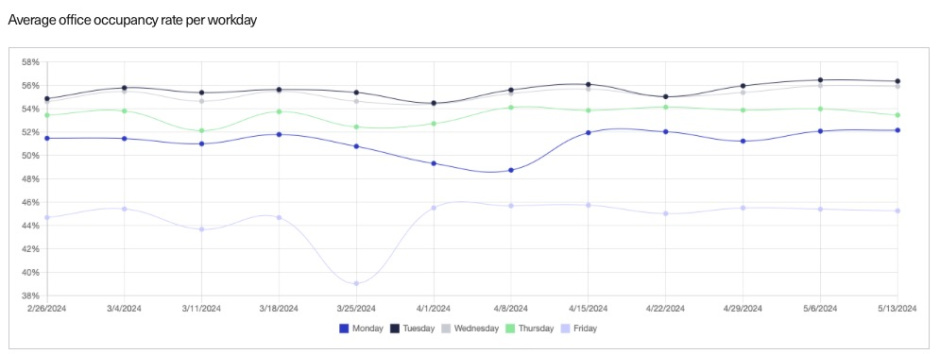
Some roles require full office presence (5 days a week.) This includes technical roles that demand access to specific equipment or internships where physical presence is crucial for personal development. The need for an in-person arrangement should be communicated to candidates prior to hiring and defined in their work contract.
Team members working partially or fully in-person will enjoy the advantage of meaningful collaboration with other team members, co-founders, and opportunities for networking with visitors, customers, and partners. This collaborative environment may contribute to accelerated career development by fostering meaningful connections, learning opportunities, and organic engagement within the company's professional community.
Hybrid work #
An arrangement that allows a team member to split their time between working from the company office and a remote location (usually their home). A hybrid work schedule includes 1-3 days working from a remote office and 2-4 days working from the office. Hybrid working arrangements are established upon hiring and exclusively extend to location and do not encompass a flexible working schedule. This has great advantages, some of which include:
On remote days:
- Saving time on commute
- Able to do more quiet work
- Facilitate other responsibilities, like accepting packages at home, overseeing sick kids, or letting in home improvement vendors
On office days:
- Able to in-person work with people at the office
- A productive environment if the home offers too many distractions
- The possibility to meet clients, new hires, or interview candidates in person
From Kisi’s occupancy research, typically, you will notice a lower occupancy on Monday and Friday - which points to at least some of your staff working on a hybrid work model.

Digital work #
Also called remote work or work from home (WFH): Individuals in this category exclusively work from a remote location, eliminating the need for any weekly office presence (although occasional travel may be necessary). Digital work is a viable option for individuals residing beyond a commuting distance of 70km (45 miles) from the office or facing circumstances, such as severe medical reasons, that prevent them from coming to the office. Digital working arrangements are established upon hiring or can be discussed upon life-changing events preventing them from working hybrid/in-person.
Research indicates that remote work enables many workers to re-enter the workforce more easily. However, on the other side, it can also feel or be a more transactional type of work. A key element of remote work is the ability to have clear goals, established roadmap and expectations to reach them and self directed execution of that roadmap. The two types of remote workers we see work well are leaders or specialists who have a high degree of autonomy. On the other hand, some workers who prefer a remote work style close to home have a personal focus on work-life balance and seem to be less career ambitious.
In-person collaboration and productivity categories in spaces #
Choosing the right space for the right purpose will increase collaboration and productivity. People and data-driven companies go out of their way to ensure that in critical moments, their employees can come together, socialize, and forge the bonds they need to work successfully together. Typically, companies bring together employees for all-hands at the offices, customer demos, or showroom meetings on the sales side. This could transform offices into office hubs and experience centers.
The question here is why even leave the house when you can work from home? Liza Mash Levin, thought leader in the workplace space says: “I for example want to get out of my house because I have little kids at home. Being at work allows me to focus more and collaborate with others better than working remotely. Our research shows that 50% of people said they want to see other people at offices. This is why facilities have been reorganized as think tanks or coffee areas for collaboration. It also promotes the rise of third spaces that shorten commute but still provide benefits of the corporate office.”
Let’s look at some examples of how to increase team alignment and motivation through physical meetups during onboarding, off-sites, or in-person functional meetups.
In-person onboarding #
Getting new hires to meet their managers, peers, or even HR teams for an AMA session has a huge impact on the quality of onboarding, new hire engagement, and their initial sense of belonging, especially for younger professionals just starting their careers.
In-person offsites #
Hosting offsites, whether for your entire team, a department, or several teams kicking off a project, is a great way to boost engagement, foster connections, and facilitate relationship-building for employees who collaborate but don't see each other often. Offsite locations don’t need to be only exotic. It can also be a change of scenery in the same city that requires less commuting than the regular office. This typically leads to the rise of the third space.
In-person functional meetups #
Pretty straightforward, but hybrid teams do benefit from catching up in a regular cadence. The frequency can vary often, ranging from 2x-a-week coworking days to team meetups once a month. Employees love seeing each other regularly and having an easy way to do so.
Workplace strategy #
Once you have analyzed your workplace data and defined the workplace and work model you want to have, you can use the templates for plans, policies, and tools below to start putting the workplace strategy into action.
Return to office templates, plans, policy and tools #
Since the US Department of Commerce issued a free RTO toolkit in 2022, many more advanced forms of templates and products have emerged to manage RTO. HR tools have started to publish RTO plans, Remote Work Policy Templates and magazines about RTO policy.
Return to office policy examples (can be copied as template) from Flex Index.
The three general categories of hybrid workplace tools come from three different backgrounds: Traditionally coworking-focused, office collaboration tools, and traditionally real estate-focused platforms.
How to measure the success of hybrid work initiatives #
Internal on-site meetups typically produce a spike in occupancy. This can easily be measured, and when it happens, you can see what made it a successful initiative.
"According to research, nearly 80% of offsite events lasted a day or less, with employees traveling less than 1 hour to 60% of the events.", shares Liza. From an analysis perspective, you can often overlay initiatives with data outliers and then understand how they went.
If you currently have workplaces that feel empty and employees unmotivated to work from offices, you can track some of the following KPI back to work initiative examples:
- Office footprint
- Average attendance as % of total desks
- Office mandate adherence
- Sq Ft per employee
- eNPS
- Turnover rate
- % of fully remote employees
- Desk sharing ratio
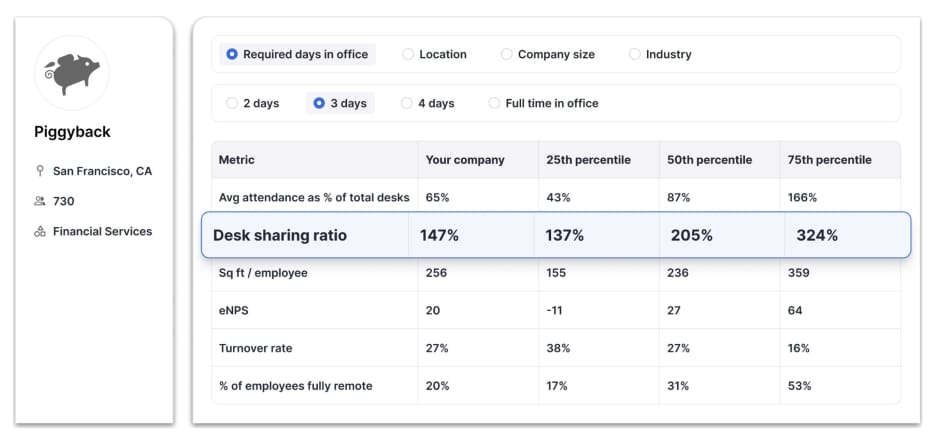
While intuitively reducing offices or forcing staff back to offices might seem the most straightforward, we believe a long-term hybrid work strategy yields best results in worker motivation as well as company productivity.
Generally, people strategy and workplace strategy are intertwined now more than ever.

Expert opinions on occupancy data & the future of work #
We’ve asked some experts in return to work to tell us their opinion:
Liza, CEO Gable: “There is a difference between what leadership wants vs what employees want. The CEO wonders: Why do we pay for the massive space? And that puts pressure on the people team to have to set the wrong goals. First you need a blueprint on how the office operates - be very clear and consistent. It’s hard for employees if they don't know the goals, purpose, and resources of the office.”
Michael, Flex Index: “Occupancy data in today’s way of working has evolved and increased in relevance. Occupancy was a fixed input before, but with flexible work is a more variable equation. Office occupancy can vary by team, seniority, and tenure within a company. For instance, some companies might consider the junior team members being on site as more essential to create camaraderie and career growth. Given the variability of attendance, looking at occupancy rates compared to other companies with similar office requirements is critical to have apples-to-apples comparisons. This is why we created Office Benchmarks. Office Benchmarks combines flexible work policy and workplace metrics to enable leaders to accurately assess their investments and policy decisions relative to peers."
The future of work: Back at the office, hybrid or remote? #
Let's sum up what we learned from this extensive article. RTO (Return to office) fails when the leadership looks to enforce face-time without productivity gains. Collaboration is essential to promote a return to in-person as it’s not about monitoring people but enabling collaboration and productivity. Different work-styles can co-exist, and occupancy data derived from access control systems can help plan it out.

